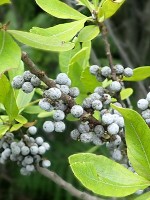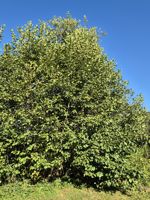Mon-Fri 9am - 5pm Mountain time
Northern Bayberry vs Mountain Alder
Myrica pensylvanica
Alnus incana subsp. tenuifolia
NOT AVAILABLE THIS SEASON - MIGHT RETURN
CUSTOM GROW
Northern Bayberry makes an excellent hedge or feature shrub. It will retain its leaves in warmer climates but drops them in colder areas. They produce blue-grey berries that have a wax coating on them that can be used to make candles or soaps.
In colder hardiness zones the leaves turn an attractive orange to red colour in the fall, making it a striking addition to your landscape.
Northern Bayberry is native to Nova Scotia and tolerates both drought and wet conditions. It is also a nitrogen fixer that tolerates poor soil conditions.
Mountain Alder is a native cold-hardy shrub or small tree often found along streams and in moist forested habitats. Its nitrogen-fixing ability enriches soils and supports surrounding vegetation, while its extensive root system helps stabilize streambanks and slopes. The fast growth rate allows it to establish quickly on disturbed sites, making it especially valuable in reclamation, restoration, and erosion control projects.
Often forming dense thickets, Mountain Alder enhances habitat quality in riparian and upland areas. It provides food and cover for various wildlife, including birds and small mammals. Recognized as an important species for soil and water conservation, it is well suited for riparian planting, naturalization, and ecological restoration.
Note: We use Sitka Alder for Alnus incana subsp. tenuifolia. This species is also known by many other common names, including Grey Alder, River Alder, and others. Please confirm the scientific name to ensure you are ordering the correct plant.
Northern Bayberry Quick Facts
Mountain Alder Quick Facts
Toxicity: Warning: The wax from bayberry fruit is considered toxic and may be carcinogenic.

